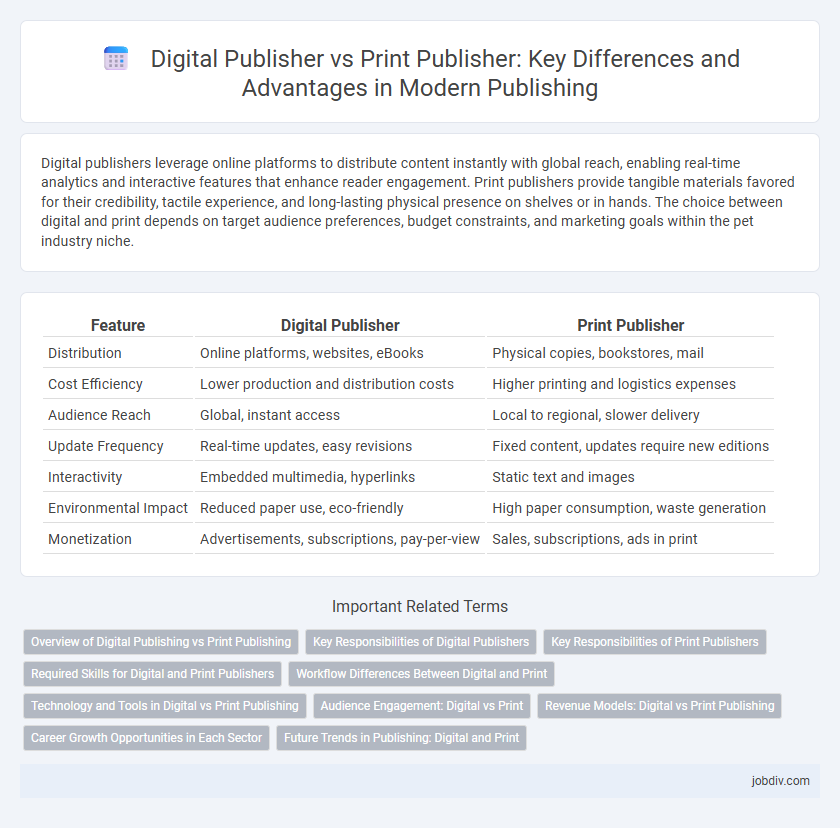Digital publishers leverage online platforms to distribute content instantly with global reach, enabling real-time analytics and interactive features that enhance reader engagement. Print publishers provide tangible materials favored for their credibility, tactile experience, and long-lasting physical presence on shelves or in hands. The choice between digital and print depends on target audience preferences, budget constraints, and marketing goals within the pet industry niche.
Table of Comparison
| Feature | Digital Publisher | Print Publisher |
|---|---|---|
| Distribution | Online platforms, websites, eBooks | Physical copies, bookstores, mail |
| Cost Efficiency | Lower production and distribution costs | Higher printing and logistics expenses |
| Audience Reach | Global, instant access | Local to regional, slower delivery |
| Update Frequency | Real-time updates, easy revisions | Fixed content, updates require new editions |
| Interactivity | Embedded multimedia, hyperlinks | Static text and images |
| Environmental Impact | Reduced paper use, eco-friendly | High paper consumption, waste generation |
| Monetization | Advertisements, subscriptions, pay-per-view | Sales, subscriptions, ads in print |
Overview of Digital Publishing vs Print Publishing
Digital publishing leverages online platforms and e-books to distribute content instantly and globally, enabling interactive multimedia integration and real-time updates. Print publishing relies on physical materials like books, magazines, and newspapers, emphasizing tangibility and traditional distribution methods. Digital formats offer cost-effective scalability and analytics-driven audience insights, whereas print maintains enduring appeal through physical presence and collectible value.
Key Responsibilities of Digital Publishers
Digital publishers oversee content creation, distribution, and monetization across online platforms, ensuring SEO optimization and user engagement through multimedia integration. They manage digital advertising strategies, analytics tracking, and social media presence to maximize audience reach and revenue. Unlike print publishers, digital publishers prioritize real-time content updates, interactive experiences, and data-driven decision-making to adapt rapidly to market trends.
Key Responsibilities of Print Publishers
Print publishers manage the entire production cycle of physical books, from content acquisition and editorial oversight to layout design and printing coordination. They ensure high-quality paper selection, color accuracy, and timely distribution to bookstores and libraries. Print publishers also handle inventory management, rights licensing, and marketing strategies targeted at traditional retail channels.
Required Skills for Digital and Print Publishers
Digital publishers require proficiency in content management systems, SEO strategies, and data analytics to optimize online visibility and engagement. Print publishers must excel in traditional editing, layout design, and project management to ensure high-quality physical publications. Both roles demand strong communication and marketing skills, but digital publishing emphasizes technological adaptability and real-time audience interaction.
Workflow Differences Between Digital and Print
Digital publishers utilize automated content management systems and real-time editing tools to streamline the publishing process, enabling faster updates and multi-platform distribution. Print publishers rely heavily on physical proofing, manual layout design, and coordination with printing presses, which requires longer lead times and meticulous quality control. Workflow differences highlight digital publishing's emphasis on agility and scalability, contrasting with the print model's focus on precision and tactile production.
Technology and Tools in Digital vs Print Publishing
Digital publishers leverage advanced content management systems (CMS), analytics platforms, and automation tools to streamline distribution, enhance user engagement, and personalize content in real-time. Print publishers rely on traditional prepress software, offset printing technology, and physical proofing methods to ensure high-quality output and accurate color reproduction. The integration of AI-powered design tools and cloud-based collaboration platforms distinguishes digital publishing technology from the more static, hardware-dependent print production process.
Audience Engagement: Digital vs Print
Digital publishers leverage interactive content, real-time analytics, and multi-platform distribution to engage a tech-savvy audience, boosting user interaction and personalized experiences. Print publishers rely on tactile appeal, trusted credibility, and deep reader immersion, targeting audiences who value physical connection and focused consumption. Audience engagement in digital publishing often results in higher content adaptability and immediate feedback, whereas print enables long-term retention and brand loyalty through tangible media.
Revenue Models: Digital vs Print Publishing
Digital publishers primarily generate revenue through advertising, subscription models, and sponsored content, leveraging data-driven strategies to optimize user engagement and target advertisements effectively. Print publishers rely heavily on physical sales, print advertising, and distribution partnerships, facing higher production and logistics costs that impact profit margins. The shift towards digital has introduced scalable monetization opportunities and real-time analytics, enabling publishers to adapt revenue models quickly compared to traditional print publishing.
Career Growth Opportunities in Each Sector
Digital publishers offer accelerated career growth opportunities with skills centered on data analytics, SEO, and multimedia content creation, adapting quickly to evolving technology trends. Print publishers provide deep expertise in traditional editorial processes, production management, and long-form content, fostering careers in legacy media and specialized niche markets. Both sectors demand strong project management and content strategy skills but differ in pace and technological integration shaping advancement paths.
Future Trends in Publishing: Digital and Print
Digital publishers leverage advanced analytics and AI-driven personalization to deliver targeted content, driving future growth in audience engagement. Print publishers focus on incorporating augmented reality and eco-friendly materials to enhance tactile experiences and sustainability. The publishing industry is evolving towards a hybrid model combining digital innovation with print's tangible appeal to meet diverse consumer preferences.
Digital Publisher vs Print Publisher Infographic

 jobdiv.com
jobdiv.com